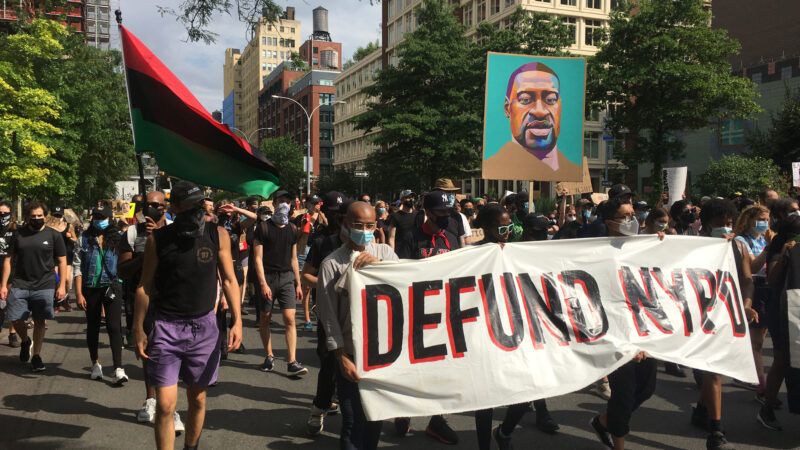City Investigators Call Out NYPD for Using Excessive Force Against Protesters
Police response “likely escalated tensions and the potential for violence” say investigators.

New York City police officers used excessive force in their response to protests following the May 25 killing of George Floyd by a Minneapolis police officer, according to a report from New York City's Department of Investigation (DOI). Police treatment of those demonstrating against law enforcement excess went so far, at times, as to undermine their own legitimacy, acknowledged the head of the agency that produced the report.
Investigators offer recommendations for improving New York Police Department (NYPD) interactions with demonstrations in the future. But nothing in the report can ease the inherent tensions when cops are themselves the targets of the protests they're monitoring, and little evidence that police are open to changing their ways.
"Nationwide protests following the deaths of George Floyd and Breonna Taylor at the hands of police were met, in many cities, by even more police violence," Reason's Scott Shackford noted last July. "In New York City, dozens of incidents in which police responded with excessive force were caught on camera. But so far, the department says only four NYPD cops have been disciplined."
Individual incidents remain under internal investigation by the Internal Affairs Bureau and the Civilian Complaint Review Board, for what that's worth.
The current report focused on NYPD responses to George Floyd protests at an institutional and systemic level, DOI Commissioner Margaret Garnett specified in a December 18 press conference. While pointing to "violence and property damage by some protesters," Garnett also admitted that "our investigation found that the NYPD as an institution made a number of key errors or omissions that likely escalated tensions and the potential for violence."
The report said NYPD lacked a strategy for dealing with protests where police conduct was the target, defaulting "to an application of 'disorder control' tactics and methods, without adjustment to reflect the NYPD's responsibility for facilitating lawful First Amendment expression."
The report pointed to indiscriminate use of force on peaceful protesters and rioters alike. That force included "encirclement (commonly called 'kettling'), mass arrests, baton and pepper spray use, and other tactics." Among the examples of such tactics was an incident on June 4 when "officers began executing mass arrests for curfew violations, which were accomplished in part by using physical force against protesters, including striking them with batons."
"Some policing decisions relied on intelligence without sufficient consideration of context or proportionality," the report added. The implication is that the intelligence was used to justify forceful tactics rather than to determine appropriate responses.
DOI investigators also noted that, except for some specialized units, "most officers responding to the protests had not received recent relevant training for policing protests." Even after the protests, remedial training emphasized disorder (riot) control rather than de-escalation and community affairs.
The outcome of missteps in May and June was the abusive use of force against peaceful protesters who were not attacking people or vandalizing property. That likely raised tensions and fanned the flames of violence as some protests escalated into actual riots and looting.
But more is at stake beyond the impact on demonstrators and bystanders, as Garnett specified in her press conference. "Policing is a vital service, and its success depends heavily on public trust and legitimacy," she said. "Aspects of the NYPD's response to the Floyd protests undermine this trust and their own legitimacy."
Police who behave as thugs aren't improving their standing at all in the minds of people who are already protesting against abusive policing. To the contrary, they harden opposition and set the ground for repeat conflicts at a time when some people are calling for entirely abolishing police and many more favor widespread reform.
The DOI report offers recommendation that will, hopefully, improve police response to future protests.
"NYPD should draft a Patrol Guide policy specific to policing protests and protected First Amendment activity," according to the report. Importantly, the guide should be developed in consultation with outside parties, including civil rights attorneys.
On the same note, the report recommends moving protest management from the Strategic Response Group and its riot-oriented Disorder Control Unit to a new Protest Response Unit. The new unit would be more community oriented and, theoretically, First Amendment-friendly.
"NYPD should develop a written policy outlining reasonable limitations on the use of disorder control tactics, such as encirclement and mass arrests, specific to their use at First Amendment-protected protests," the report adds.
Still, it's obvious that a police department is going to face challenges when addressing demonstrations aimed at its own officers—especially when tempers are simmering. "NYPD officials characterized the scope of violence, the looting, and the hostility toward police as a significant difference from past large demonstrations in the City," acknowledged DOI investigators.
That has police on the defensive and less than cooperative with efforts to reform protest response.
"When DOI asked NYPD officials whether, in retrospect, the Department could have done anything else differently and made any further changes to improve its response to the protests, with few exceptions, officials offered none," the report observes. "While some difference in views is to be expected, the wide gap between the apparent views of the Department's most senior officials and the views of members of the public who participated in the protests is troubling."
That means reform in dealing with protests and in distinguishing between peaceful demonstrators and violent rioters will probably have to come to the NYPD from the outside, without the active assistance of police officials themselves.


Show Comments (53)